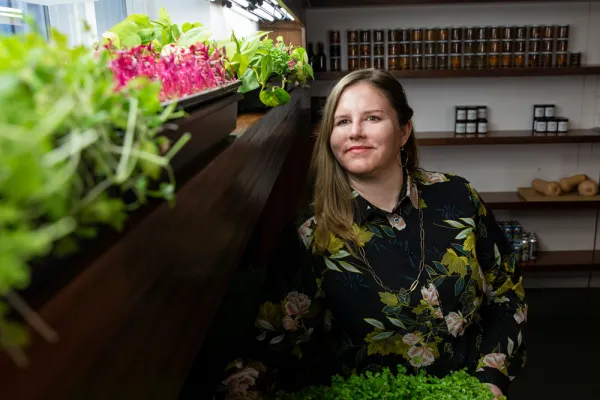Greening the City
Alumnae News

Published March 18, 2020
For the first time in decades, chefs at the Rainbow Room restaurant at 30 Rockefeller Plaza in New York City are cooking with fresh herbs and vegetables harvested directly from a garden just hundreds of feet from their kitchen. The 300-square-foot plot, which sits high atop the city in a rooftop space, is expected to yield more than 600 pounds of herbs and vegetables like dill, basil and cherry tomatoes this year—all of which will land on the plates of Rainbow Room diners.
Leading the project to revive the long-abandoned rooftop garden—known as the International Garden when it was first constructed on the 11th floor of 30 Rock in 1935—was Jessie Banhazl ’06, founder of Green City Growers. “The space had just been sitting there unused for so long,” she says. “We rejuvenated it, taking an untraditional growing space in a very urban setting and turning it into a space where you can grow food without disrupting the urban environment.” What’s more, chefs are thrilled, Banhazl says. “It gives them so much more flexibility. They can grow what they need, instead of relying primarily on outside vendors who can’t always procure what the chefs want.”
Banhazl and her Green City Growers have left their calling card—beautifully designed organic vegetable gardens and urban farms, ranging from 150 square feet to more than 20,000 square feet—in cities throughout the Northeast. The Somerville, Massachusetts–based company helps individuals, corporations, restaurants and organizations in urban areas design and maintain landscapes that perform a variety of functions, like revitalizing unused spaces and supplying fresh, locally sourced food. Among her clients are Whole Foods, Harvard Pilgrim Healthcare and Fenway Park, where GCG maintains a 5,000-square-foot rooftop farm that supplies the on-site restaurants. “Our work is a combination of creating an interactive space where people engage with the earth and plants and vegetables as well as producing food that ultimately can be used to feed the community,” Banhazl says.
The history of urban farming dates, really, from the birth of cities, but it saw a significant revival in the 1970s, when factories started moving out of urban areas, leaving behind abandoned buildings and unused plots of land. Today, people are especially eager for more control over food consumption and production, giving momentum to the hyperlocal food movement. “There is so much more visibility around food safety and security, food allergies and problems related to the food industry,” Banhazl says. “People are looking for an alternative. That alternative is producing your own food.”
The climate crisis has also driven more city residents to be mindful of using spaces in more efficient, environmentally friendly ways. “Growing your own food is a way for people to take action,” Banhazl says. “It changes your perspective and gives you a broader sense of the ecosystem that connects humans, the earth and how we feed ourselves.”
Green City Growers works closely with property managers, contractors, landlords, corporate leaders and individuals who want to transform a plot of land—or even just a windowsill—into what GCG often calls an “edible landscape.” The company’s 20 staff members also assist in maintaining the gardens they create and provide education and training workshops to clients interested in health, nutrition, farming and a range of other topics.
HOW TO GROW A CITY GARDEN
TIP 1: Start small. Try a container garden on a windowsill in your apartment. “Just make sure you have at least 12 inches of soil to work with,” Jessie Banhazl says.
TIP 2: Find a space in the sun. Healthy gardens need six hours or more of sunlight, Banhazl says. Apps like Sun Seeker can assist in finding the best spot.
TIP 3: Learn what grows best in your area. “Climate is very important,” Banhazl notes. “Choose plants that are going to thrive where you live.”
TIP 4: Plant what you can manage. “Herbs like thyme and basil—you can just plant those and forget about them,” Banhazl says. “Kale and collards are also easy. Tomatoes, though, can be a challenge because they’re susceptible to fungus.”
TIP 5: Go for it! “Get your hands dirty and just enjoy the experience of growing something,” Banhazl says. “It’s the best feeling.”
The benefits are far-reaching, Banhazl says, pointing to research that shows that diets would improve if people took a more hands-on approach to food production. When children, for example, have the experience of tending gardens, they eat three times as many fruits and vegetables as they would otherwise. Also, Banhazl says, “getting outside and working in the garden is very therapeutic and meditative.”
Some of the greatest benefits are to the environment and cities themselves. A 2016 report by researchers at Purdue University notes that between 20 percent and 30 percent of greenhouse gas emissions are caused by the global food system. On average, food travels 3,000 miles from its source. “When you cut those miles down to feet, you’re eliminating trucking, shipping, gas and all the CO2 that goes into getting something from point A to point B,” Banhazl says. “That’s huge.”
Further, rooftop gardens reduce storm runoff and help insulate buildings, Banhazl says, lowering cooling and heating costs by as much as 30 percent.
Banhazl’s journey to becoming an advocate for sustainable urban agriculture was circuitous. She graduated from Smith with “no rhyme or reason as to where my life was going” and ended up in New York, hoping to land a job in advertising or media. After a stint working in reality television on shows like Chopped on the Food Network, The Hills and Wife Swap, she took stock of what she was doing and “realized that reality television wasn’t providing much good for people,” she recalls. “Plus, I was struggling with the lack of green space and access to fresh produce on my income.”
In 2008, Banhazl moved back to the Boston area, where she’d grown up, and languished for a while until a friend recommended that she read The Omnivore’s Dilemma by Michael Pollan. The book, which explores the consequences of our food choices, was transformative and ultimately sparked the inspiration for what would become Green City Growers. She and her friend started small, installing vegetable gardens in people’s yards and providing the ongoing maintenance, which for many home gardeners is the biggest obstacle. “The big idea was to get people to see that they could grow their own food and, in many ways, detach from the food system,” Banhazl says.
More than a decade later, GCG has developed 120 sites throughout Massachusetts, Connecticut and New York that, in total, produce at least 30,000 pounds of organic produce a year. In 2017, the company was honored with the Walden Woods Project’s Global Environmental Challenge Award and was also recognized by the organization B The Change as one of the best companies for the environment.
What matters most to Banhazl, though, is knowing that her work is not only making cities greener but also improving the planet’s health for future generations. Her message is simple: “Locally distributed agriculture that comes from as close to the source as possible is going to be a much more effective approach to food production. So, grow local.”
This story appears in the Spring 2020 issue of the Smith Alumnae Quarterly.
SMITH ALUMNAE QUARTERLY
Special Climate Issue

Mission: HEALTHY EARTH
How the Smith community is fighting to save our planet
SMITH ID
JESSIE BANHAZL ’06 Founder, Green City Growers
MAJOR: Sociology